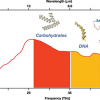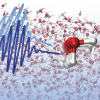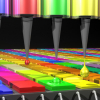Infrared Spectroscopy News
Panorama Synergy Limited has entered into an exclusive global licensing agreement with The University of Western Australia (UWA) for its MEMS-based optical spectroscopy sensor technology.
Panorama Synergy Limited has entered into an exclusive global licensing agreement with The University of Western Australia (UWA) for its MEMS-based optical spectroscopy sensor technology.
The combination of X-ray structure analysis, infrared spectroscopy and computer simulations has been used to study the switch proteins Ran and Ras with subatomic resolution.
A metamaterial absorber capable of highly sensitive infrared detection enhances the spectroscopy of tiny molecular details.
A new infrared light source with unprecedented sensitivity allows molecular fingerprints of cancer cells.
Ultrafast infrared spectroscopy has shown that long-lived sub-structures exist in liquid water by measuring the vibrations of the O–H bonds.
Rand Capital Corporation has invested $250,000 as part of a $4.3 million equity capital funding round in SciAps, Inc., manufacturer of handheld analytical instruments. The funding round was led by new investor Jolimont Global Mining Systems with participation from Rand Capital, and other existing investors including SciAps CEO and Founder Donald Sackett, as well as two additional new investors.
In initial tests, a novel near infrared spectroscopy device assesses shock severity as accurately as a standard blood sample, without a single needle prick.
A microscope being developed at the US Department of Energy’s Oak Ridge National Laboratory will allow scientists studying biological and synthetic materials to simultaneously observe chemical and physical properties on and beneath the surface.
Daylight Solutions, Inc., has received two new awards for their Spero™ microscope. Spero was awarded the 6th Annual Microscopy Today Innovation Award and was also named a finalist in the 2015 R&D 100 Awards taking place later this year.
Keynote speakers for NIR-2015 are announced, including the Tomas Hirschfeld and Karl Norris Award Lectures.
Germanium immersion gratings could enable smaller, higher-efficiency infrared spectrometers for astronomy and other applications.
Diseases like Alzheimer’s are caused when proteins aggregate and clump together. Using atomic force microscopy and infrared spectroscopy, EPFL scientists have successfully distinguished between the disease-causing aggregation forms of proteins. The finding can help change pharmaceutical treatment of neurodegenerative diseases.
Mark Venske has joined Block Engineering as the new Vice President of Sales and Marketing.
Nano-Spectroscopy and Bio-Imaging is a free-to-attend conference in October 2015 held in Coventry, UK.
Guided Wave has hired Debra Hallto in the position of VP Sales & Marketing.
The Center for Structural Biology and Bioinformatics at the Free University of Brussels (Université Libre de Bruxelles, ULB) has developed expertise in the analysis of biological molecules using infrared spectroscopy. Now, with the help of Scottish microarray instrumentation company, Arrayjet, the Center has integrated microarray technology to speed up and enhance the analysis of bio molecules such as proteins, which are exposed to hundreds of experimental conditions on a single chip using infrared imaging.
Berkeley Lab researchers’ novel diffraction spectroscopy technique will provide insight to chemical processes at important battery interface.
New spectrometer based on quantum dots is small enough to function within a smartphone, enabling portable light analysis.











